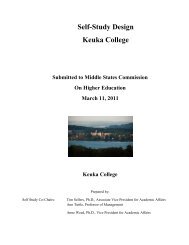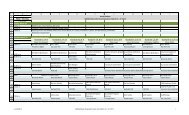final version of the self-study document - Keuka College's Middle ...
final version of the self-study document - Keuka College's Middle ...
final version of the self-study document - Keuka College's Middle ...
You also want an ePaper? Increase the reach of your titles
YUMPU automatically turns print PDFs into web optimized ePapers that Google loves.
Program and <strong>the</strong> <strong>Keuka</strong> Vietnam Program. For example, <strong>the</strong> same learning goals exist in<br />
<strong>the</strong> overseas Business programs as in <strong>the</strong> traditional program in New York.<br />
Consequently, <strong>the</strong> assessment measures are aligned among all three general locations<br />
(i.e., <strong>Keuka</strong> Park, China, Vietnam), with all students completing <strong>the</strong> capstone course BUS<br />
444 Strategic Management and taking a comprehensive business exam covering <strong>the</strong><br />
functional components <strong>of</strong> business, administered at <strong>the</strong> completion <strong>of</strong> <strong>the</strong> capstone<br />
course.<br />
Annual assessment reports for <strong>the</strong> <strong>Keuka</strong> China Program (KCP) reveal significant<br />
challenges <strong>of</strong> meeting <strong>the</strong> target goals for <strong>the</strong> comprehensive business exam, linked to<br />
English language pr<strong>of</strong>iciency and some coursework reflecting American principles and<br />
practices. This exam has been a struggle for students since piloting in Dec. 2008, and as<br />
a result, <strong>the</strong> test items were revised and a number <strong>of</strong> questions were eliminated. Poor<br />
results in subsequent years were a factor in <strong>the</strong> revision <strong>of</strong> <strong>the</strong> curriculum in 2010 and <strong>the</strong><br />
implementation <strong>of</strong> curriculum mapping and syllabus template updates in 2011 and 2012<br />
to focus on student learning outcomes. This year <strong>the</strong> spring faculty workshop will focus<br />
on assessment at course level, with an aim to build up <strong>the</strong> English vocabulary, content<br />
knowledge and analytical skills needed for business in general and for <strong>the</strong> comprehensive<br />
exam in particular. The Business Division is also considering <strong>the</strong> adoption <strong>of</strong> a different<br />
exam for 2013.<br />
Analysis <strong>of</strong> <strong>the</strong> second direct measure <strong>of</strong> program outcomes, <strong>the</strong> capstone project in BUS<br />
444 Strategic Planning, shows that 90% <strong>of</strong> all students (n=784) met <strong>the</strong> criteria for<br />
success (a grade <strong>of</strong> C). Indirect measures employed in <strong>the</strong> <strong>Keuka</strong> China Program include<br />
<strong>the</strong> Comprehensive Alumni Assessment Survey and <strong>the</strong> National Survey <strong>of</strong> Student<br />
Engagement. Customized relevant questions were combined into <strong>the</strong> Chinese student<br />
survey that <strong>Keuka</strong> administered online in May 2012 to students from <strong>the</strong> entering classes<br />
<strong>of</strong> 2008, 2009, 2010 and 2011, with a response rate <strong>of</strong> 701 students or 24%. The overall<br />
question measuring student satisfaction with <strong>the</strong> program was “If you had to do it all<br />
over, would you attend <strong>the</strong> <strong>Keuka</strong> Program?” The target is for 80% <strong>of</strong> students to<br />
respond positively, across all <strong>Keuka</strong> China campuses. Overall, <strong>Keuka</strong> met its goal for<br />
2012, with 88.4% <strong>of</strong> respondents said <strong>the</strong>y would definitely (51%) or possibly (38%)<br />
attend <strong>the</strong> <strong>Keuka</strong> China program again. (In 2010, 6% had said <strong>the</strong>y would not choose<br />
<strong>Keuka</strong> again, and in 2011, 17.5% had said <strong>the</strong>y would not attend <strong>the</strong> <strong>Keuka</strong> China<br />
program again.) O<strong>the</strong>r questions reflected student engagement, with 70% <strong>of</strong> students<br />
responding positively that <strong>the</strong>y experienced intellectual growth; a focus on experiential<br />
learning, with 98% saying <strong>the</strong>y worked with o<strong>the</strong>r students on class projects; and variety<br />
in learning style, with student responses reflecting a distribution <strong>of</strong> student experience<br />
over a range <strong>of</strong> learning styles ra<strong>the</strong>r than on one dominant type. Retention and<br />
graduation rates are a reflection <strong>of</strong> <strong>the</strong> faculty and student efforts throughout <strong>the</strong> program,<br />
and <strong>the</strong> overall cumulative graduation rate for <strong>the</strong> program from 2003-2012 is 85%.<br />
Recent improvements that were implemented in 2011-2012 include providing a <strong>study</strong><br />
guide for <strong>the</strong> comprehensive exam to KCP students, more tightly constructed syllabus<br />
templates with assessment measures tied more explicitly to course outcomes, and<br />
development <strong>of</strong> a common rubric for <strong>the</strong> <strong>final</strong> project, with sharing <strong>of</strong> work samples that<br />
Page 21 <strong>of</strong> 31 Chapter 4: Inst. Effectiveness & Assessment




